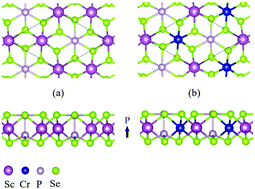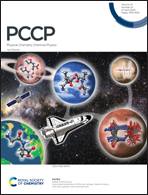Ferroelectricity and multiferroicity in two-dimensional Sc2P2Se6 and ScCrP2Se6 monolayers†
Abstract
Two-dimensional (2D) multiferroic materials with coexistence of ferroelectricity and ferromagnetism have attracted extensive research interest due to novel physical properties and potential applications, such as in non-volatile storage nanodevices. Here, using first-principles calculations, we predicted two types of 2D materials, Sc2P2Se6 and ScCrP2Se6 monolayers with ferroelectric (FE) and multiferroic properties, respectively. The Sc2P2Se6 monolayer has out-of-plane FE polarization originating from the asymmetrical arrangement of P atoms. The FE phase is separated from the antiferroelectric (AFE) phase by an energy barrier of 0.13 eV, ensuring the stability of the FE state at room temperature. The ScCrP2Se6 monolayer formed by substituting half of the Sc atoms of Sc2P2Se6 with Cr exhibits multiferroic properties. The magnetic ground state of the ScCrP2Se6 monolayer is tunable, due to the disparity of an indirect exchange interaction between the FE and AFE phases. A reversible electrical switching between the ferromagnetic and antiferromagnetic states can be achieved in a multiferroic ScCrP2Se6 monolayer. Our theoretical results offer a new platform for the further study of 2D multiferroicity and nonvolatile magnetoelectric nanodevices.



 Please wait while we load your content...
Please wait while we load your content...